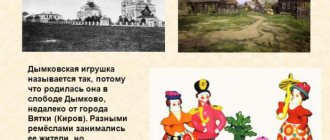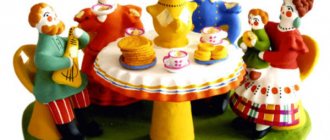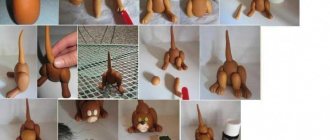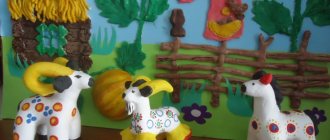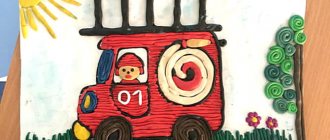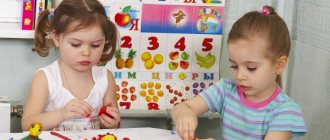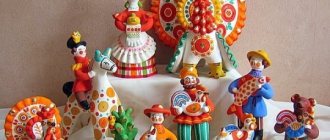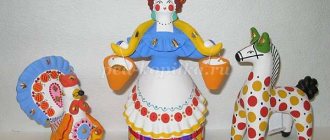Simple coloring pages of Dymkovo patterns for young children
Abstract on drawing on the topic “penguins” for children of the older group
Children's development will benefit from painting large components of a drawing, using the most saturated colors.
Among the most popular options for such pictures:
| Drawing for coloring | Description of the drawing and the principle of working with it |
| Horse. The task for the child will be to color the horse in the way he thinks will be as beautiful as possible. Typically, children are asked to use red, white, orange and yellow pencils. This set of colors, as a rule, is sufficient not only for their individual use, but also for creating new shades. In this version of the coloring book, the child, if desired, can complete the animal’s face, or can simply add brightness to the picture, without adding patterns to it. | |
| Matryoshka. Coloring this picture of a matryoshka doll is best combined with telling your child the history of the origins of the original Russian toy. It will also be interesting for the child to learn the principle of playing with such a wooden doll. Pencils of red, black, white and yellow are usually used to add color to this sketch. | |
| Lady. The process of coloring the lady will also be a fun activity for kids. Despite the apparent simplicity of the design, giving it color requires thinking through the shades used in the work. To complicate the task, the child can be given the goal of coloring the outline of a woman so that the items of her clothing match each other and do not merge. For this purpose, it is recommended to invite him to choose a shade to work with from an unlimited number of pencils. Experience shows that children most often choose red, yellow, green, blue, black and white. |
Manufacturing secrets
It is easier for children to make a Dymkovo toy from plasticine. But real masters use local red clay for their work, mixing it with river sand. All parts of the figures are molded separately and then connected. The joints are smoothed using liquid clay.
The resulting toys are first dried in air and then fired in a hot oven. The surface is whitened. In the old days, for this purpose, they took chalk and diluted it in milk. The paints were made from chicken eggs mixed with kvass. The patterns were drawn with a pen. They were simple: circles, dots, wavy lines, zigzags. Moreover, each element had its own meaning. The circle symbolized the sun. Dots depicted human footprints. The wavy line reminded of water, the crossed stripes indicated a well.
The colors used were bright and festive. To give the finished toys a shine, they were coated with beaten egg white.
Making a young lady from plasticine
Since ancient times, skilled craftsmen from the village of Dymkovo have been creating figures of girls. Among them one can distinguish real young ladies in a kokoshnik, as well as simple peasant women with children in their arms or buckets on rocker arms. Despite the wide choice of decoration, all female figures have a fairly simple general shape, with the help of which you can easily understand that this is a Dymkovo figurine.
You can create a young lady from plasticine. For a beautiful and fluffy skirt, we need a frame - you can take the cut off neck of a plastic bottle. It needs to be covered with a thin layer of plasticine, while maintaining its original shape. After this, based on the bottle cap, you need to form a body and attach a ball-head to it. Next, you can give free rein to your imagination, use all possible creativity - sculpt your hands, headdress and hair. You can also decorate the figurine with additional decor, or give the young lady something in her hands. The finished figure must be additionally coated with primer and painted.
Instructions for step-by-step creation of a figurine
To create a young lady you will need:
- plasticine;
- modeling board;
- napkins;
- plastic bottle with a total capacity of 0.5 liters (future skirt).
For modeling you need a frame - most often it is created with a plastic roll, its shape is very similar to the skirt of a Dymkovo young lady, the roof must remain in place so that the plasticine does not fall inside.
If a child creates a figurine, then parents should help him with the frame. Depending on the shape of the bottle, the young lady will have the same skirt.
Manufacturing technology
The famous toy is made in stages. And these stages are represented by modeling, mandatory drying, firing, whitewashing and painting itself.
Making a Dymkovo toy step by step:
- Modeling. The figure is sculpted in parts. Take oily, washed clay, diluted with sand. Balls of different sizes are rolled out of it. Then they are flattened into a flat cake. The body of the toy is made from them, and small parts are attached to the body. The joints are thoroughly moistened with water, and then the joints are smoothed with a wet cloth. For example, a horse consists of a cylindrical base, four short cone-shaped legs, and a curved neck with a muzzle.
- Drying and firing. The drying stage is required. How long to dry depends on the size of the craft, and on the characteristics of the room too. Previously, firing was carried out in a Russian oven; toys were literally heated red-hot and left to cool in the oven. Today, figurines are fired in special modern equipment, thanks to which the process is no longer so labor-intensive and, of course, less dangerous.
- Whitewash. After being in the oven, the toy turns red-brown. You can’t apply patterns to such a base, so the craftsmen always bleach it. This happens using a solution of chalk powder and milk. When the milk sours, the solution hardens and an even casein layer forms on the surface. Surprisingly, numerous ways to simplify the whitewashing stage led to nothing. And today they whitewash a toy in the same way as many centuries ago. Only children in class can paint the figure with white gouache.
We invite you to watch a video on how to sculpt a toy body and attach parts using the example of a horse.
The processing continues with one of the most interesting stages – painting.
Are there any masters of Dymkovo toys now?
The traditions of creating Dymkovo toys are still alive. This process never became automated and serial. The figurines are still painted by hand, according to the rules that existed 400 years ago, when this folk craft first appeared. However, not all young masters have the patience to complete the learning process, but those who comprehend it completely become real professionals. With their own hands they create fascinating images of Dymkovo toys, each of which is individual and unique.
The creation of Dymkovo toys was and remains a woman's profession. Flights of fantasy and knowledge of ancient traditions and customs help the fair sex to create incredible images and convey them in a whole range of rich colors.
Thanks to the Dymkovo toy, which has existed for more than 400 years, the rich history of the Russian people and their cultural heritage continues. These bright and unusual figurines delight the eye and lift your spirits; they immerse you in an exciting fairy tale, the unique and original plot of which each person comes up with for himself. And, although the Dymkovo toy has now lost its ritual meaning, it continues to be a symbol of the generosity of the soul, good spirits and boundless kindness of the Russian people.
History and traditions of Dymkovo painting
Dymkovo toy, 19th century. According to an ancient legend, two squads met near the city late at night. And even though they were allies, in the darkness the warriors could not recognize each other, and a battle took place that claimed many heads. Every spring, the locals held a funeral feast for the victims of the absurd, accidental, and even more tragic battle. History began to be forgotten, but the tradition of organizing a spring meeting remained. And it turned into mass celebrations, a pandemonium festival, at which it was customary to playfully throw painted stucco balls.
Here is such an interesting history of the origin of the direction. It was the demand for balls and whistles that contributed to the development of the direction. This happened in the Dymkovo settlement, the birthplace of an outstanding craft. Over time, masters began to use sculpting and painting techniques: one after another, they carefully passed on their skills to their followers. When the ritual meaning of toys began to be lost, the products themselves began to change - they became more beautiful and artistic. And today, painting of Dymkovo toys has become part of decorative and applied art; ritual significance has receded into the background.
You will learn more about the history of the craft from the article: “The history and technology of creating crafts of Dymkovo clay toys.”
What is a Dymkovo toy?
Notes of nodes for children of the senior group application
Dymkovo toy is one of the Russian folk crafts. This craft originated in the settlement of Dymkovo (not far from the city of Vyatka), most likely from the custom of making clay whistles for the holidays.
Today, Dymkovo toys include not only whistles, but also any craft toys made of clay, intricately and brightly colored. Each toy is a unique work of a specific master.
Some online resources sell Dymkovo toys at fairly high prices, but no one is stopping parents and children from creating something similar themselves and being, at least for a short time, the masters of Dymkovo toys themselves.
Complex coloring pages with a lot of small elements
Dymkovo toys (templates for drawing, as well as drawings for coloring, are freely available on the Internet), due to the variety of their options, can be used in work with older children.
For schoolchildren attending grades 3–5, it will be interesting to paint more complex patterns with a lot of small details.
Teachers recommend drawing parents’ attention to the following pictures:
| Sketch for coloring | Description of the drawing and the principle of working with it |
| "Walk". This picture for coloring is a complete artistic composition. It depicts a man and a woman floating in a boat on a river. The task facing the child is to make colorful not only people’s costumes, consisting of small parts, but also the objects surrounding them. These include the celestial bodies, the pattern on the ship and the waves. The main colors that the student will work with are red, blue, white, black and their derivatives. | |
| "The Bears". This sketch shows a family of bears. Animals are depicted in human form: they wear clothes and jewelry. The difficulty in coloring this drawing lies in the large number of small details of the characters' clothing. To complicate the task, you can invite the child to make the picture as realistic as possible (paint the bears in the appropriate colors, as in life, and their clothes in the shades most often found in adult wardrobe items). Typically, children work with this image using blue, red, black, yellow, brown and white colors. | |
| "Rider". This is one of the most popular pictures for coloring, used by teachers when working with them. It depicts a boy standing on a horse. In this case, the child will need to carefully paint the smallest details of the image of the young man, as well as reproduce the color of the animal and surrounding objects. It is recommended to work with brown, black, red, blue, yellow, orange, blue and green. |
Options for Dymkovo toys
The most famous images of Dymkovo toys are a lady, a turkey, a lamb, and a horse. Less common are other characters and pets. The main difference between Dymkovo toys is their bright colors and funny stories. It is easy to create certain compositions from many Dymkovo figures. The Dymkovo toy, despite its canonicity, retains the individuality of the master. Dymkovo turkey or peacock
A bright turkey, as colorful as a peacock, with a long scarlet beard decorated with gold leaf. The sizes of this toy vary: from tiny - 5 centimeters, to an impressive 40 cm. Dymkovo lady
A lady is an elegant city lady or a traditional lady wearing a kokoshnik. In the hands of the figurine there may be bread, a handbag, a bucket, or a double toy - a lady on the arm of a gentleman.
Dymkovo lamb
Lamb - the figures may differ in the size of the horns and the coloring of the body, but there is often gilding. Dymkovo horse
The horse is a traditional figurine with bright blue spots - “apples”. Male images in the Dymkovo toy are played out in the form of a rider on a horse, an idle city or village “cavalier”.
Figurines of dogs, pigs, birds, and bells are popular.
Painting a Dymkovo toy
Clay figurines symbolize joy and life. For decoration, a smooth ornament is usually used in combination with a geometric pattern. Contrasting shades are selected that highlight each other favorably.
Elements of people's wardrobe, horns and hooves of animals are covered with copper leaf.
Colors of Dymkovo toys
After the whitewash dries, the craftsmen begin applying patterns to the figurine. The painting of the Dymkovo toy has a meager range of colors:
- Blue.
- Green.
- Yellow.
- Brown.
- Orange.
- Crimson.
| To obtain additional shades, the main color was diluted with chalk. For example, blue was obtained from blue in a similar way. |
In the old days, craftsmen used wooden sticks wrapped in pieces of linen fabric to paint figures rather than brushes. A similar tool made it possible to create primitive patterns: lines, circles, zigzags. Nowadays, for painting, they take brushes from ferret hair.
To make the paint shine, a raw egg was added to it. Coloring was carried out in a certain sequence:
- The hair was most often covered in a brown tone.
- The eyes and eyebrows were painted with black paint.
- The mouth and cheeks were indicated with a crimson tint.
- The headdress is monochromatic.
- Pattern on the outfit.
The last stage was decorating the toy with decorative figures carved from gold leaf.
Elements of Dymkovo painting
Craftsmen always used a strict geometric pattern to decorate a clay figurine. Toy painting is a combination of circles, wavy lines and zigzags. Cells, dots and spots are required. Also included in the coloring elements are rhombuses made of gold leaf or gold leaf, which are glued on top of the applied ornament.
Each craftsman applies a pattern in accordance with personal wishes, combining different combinations. The product can be completely covered with ornaments. In some cases, the author's brevity is observed. Therefore, among the wide range of toys, it is impossible to find two identical figurines.
The painting of Dymkovo products is characterized by the use of special symbols denoting the desire for beauty and truth. All ornaments are closely related to nature and various amulets.
Every detail of the drawing has a hidden meaning. For example, a wavy line symbolizes water, a circle with a star in the center symbolizes the sun. Often the ornament contains plant elements: flowers, leaves and berries.
Characteristic features of animal painting
Each clay figurine is painted differently. Classic figurines of horsemen, roosters and other characters beloved by the people are covered with rich colors. The horse can be decorated with bright blue apples on its sides, and the turkey can acquire a fan-shaped tail.
| A characteristic feature of winged ducks was a row of horizontal frills. When you looked at the duck, it seemed like she was wearing two aprons. |
In addition, painting requires adherence to a certain sequence when applying the pattern. The first to apply is a wide strip that covers the breast of the duck. Narrow lines extend from the neck, then the master applies transverse strokes, forming a classic checkered pattern.
The painting of whistles in the shape of a skate combines the application of vertical stripes and a number of polka dots of different colors. In this case, the shades used do not combine with each other.
The most popular animals in Dymkovo toys are the horse and the duck. Much less common are piglets, cows, goats and other domestic animals. The anatomical structure of the body is usually not respected, so most of the animals resemble a horse. Only by the face can one recognize what kind of creature the potter depicted.
